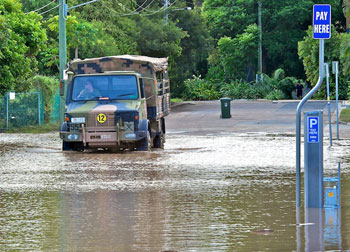
THE FLOODS, and now cyclone, which have affected so many people in Queensland have touched the hearts and minds of Australians in an outpouring of grief and concern.
The media has brought saturation coverage of every aspect of the event; yet in the months and years that follow, the process of recovery will continue unseen. What is that process, and how might the church be engaged with it?
Ray Scurfield, Associate Professor of Social Work at the University of Southern Mississippi, studied recovery of communities including New Orleans post-Hurricane Katrina and built a schema of stages of disaster recovery.
This has been very helpful in understanding and addressing what communities go through post-disaster. It is similar to Kubler-Ross’ stages of grief, in that communities may move through these stages at different paces; skipping stages, or returning to them on the way to a new future.
The Heroic Stage
This describes the time of initial impact. It is during this time that neighbours help neighbours and locals, fuelled by adrenaline and concern, perform wonderful acts of bravery, altruism and care.
In the heroic stage people use their energy to save the lives and property of others, and the most important resources are family groups, neighbours and emergency teams. Here the church is in the community and is as affected as much as anyone else.
The Tunnel Vision Stage
When the adrenaline has passed, many people will be in a state of shock, or general numbness. People are overwhelmed, tired and emotionally numb. They can only deal with one thing at a time: cleaning mud out of a house or arranging the next meal, operating on a moment-by-moment basis.
This is not a good time to make major life decisions. During this stage, the most important resources are family, friends, work colleagues, church and prayer (allowing people to focus and meditate). Just being with people and walking through this with them is invaluable.
The Honeymoon Stage
This stage can last from one week to six months after a disaster’s impact. There is a strong sense of having survived and come through a catastrophic event together.
People are buoyed up by promises and expectations from agencies and politicians.
Here people clear out debris and wreckage, witnessing and expecting help to get things back on track. The church’s great strength here is its being a pre-existent part of the community.
The Disillusionment Stage
This can begin within days of a disaster, but commonly starts around the third week post-disaster and may last from a few months to up to two years. This holds a strong sense of disappointment and disillusionment, even anger and resentment where there are delays or unfulfilled promises.
Media attention will move on to other things; people will feel forgotten. Here is where the spiritual need will be most pronounced. There is often a breakdown in community at this time as people lack the energy to connect with other people and look after their individual problems.
A focus on cross-Presbytery and congregational support and signs of love are important. My congregation has intentionally knitted and sent “wraps for love” to congregations in fire-affected Victoria many months and even a year after the fires hit. The feedback was that they were delighted that “someone remembered us”.
I have observed that six-months after a disaster is a time when ministers experience some level of burn-out or compassion fatigue. They need to be urged to go on leave and get right away and ensure they take their days off.
Reconstruction / Recovery Stage
This lasts for several years after a disaster. In this phase, affected people realise the need to take hold of their own future, encouraged by visible recovery efforts. The strength of this phase is in people seeing progress in recovery efforts, and their belief in their capacity to recover and hope for the future. The most important resources during this time are community groups with a long-term investment in the community and its people.
Here the church needs to be consciously determined to be there for the long haul. Perhaps the greatest gift the church can bring through these times is a commitment to being there for the long haul as an agent of hope within the community.
Rev Dr Stephen Robinson is the Disaster Recovery Coordinator for the Synod of NSW and ACT
Photo : Beesley Street, West End, Queensland. Photo by Lewis Yu
 JourneyOnline
JourneyOnline






